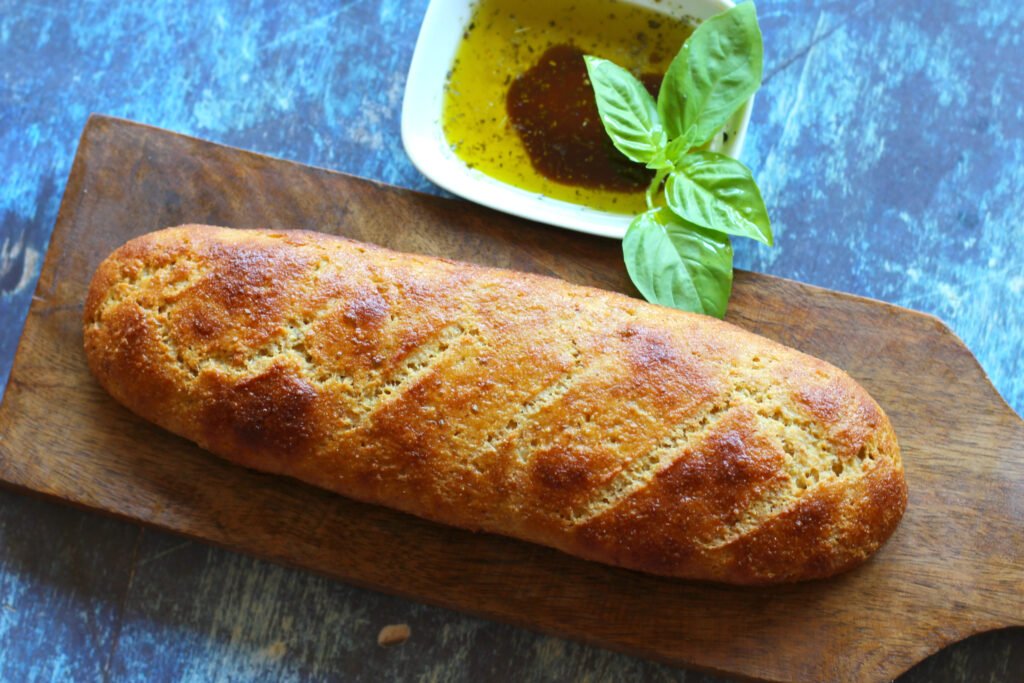October 9, 2024 – By Alex Magalhaes
Discovering the World of Keto Bread
The ketogenic diet, or keto, is a popular low-carb, high-fat eating plan designed to trigger a metabolic state called ketosis. In ketosis, the body shifts from using glucose as its primary energy source to burning fat, making it a go-to option for weight loss and enhanced metabolic health. Despite its benefits, many people find it challenging to give up traditional, carb-heavy foods like bread and desserts when starting the keto diet.
Fortunately, keto-friendly bread and desserts have become essential alternatives for those committed to a low-carb lifestyle. These treats are crafted with ingredients that are low in carbs and high in healthy fats and fiber, making them compatible with the ketogenic diet without sacrificing taste. Using ingredients like almond flour, coconut flour, and natural sweeteners, these recipes allow keto followers to enjoy familiar textures and flavors while staying within their dietary goals.
The Role of Keto Alternatives in a Sustainable Diet
Incorporating keto-friendly bread and desserts can play a significant role in helping individuals stick to their dietary plans. Traditional bread and sweets can often trigger cravings, making it harder to adhere to a low-carb lifestyle. By providing satisfying alternatives, keto bread fulfills cravings for the texture and flavor of traditional bread without the high-carb content. Similarly, keto desserts allow people to indulge their sweet tooth without raising insulin levels or breaking ketosis. This balance not only enhances the diet’s enjoyment but also supports individuals in their journey toward improved health and well-being.
Understanding the Science Behind the Keto Diet
The keto diet revolves around drastically reducing carbohydrates while increasing fat intake, to achieve ketosis. This metabolic state encourages the body to utilize fat stores for energy, producing ketones as an alternative fuel source. The typical macronutrient ratio for keto is about 70-75% fats, 20-25% protein, and only 5-10% carbohydrates.
Unlike traditional diets that prioritize carbs for energy, keto’s low-carb approach stabilizes blood sugar levels and minimizes insulin spikes. This shift has been shown to provide benefits such as improved mental clarity, sustained energy levels, and more efficient weight management. For those adopting the keto lifestyle, having access to low-carb bread and desserts is crucial for staying on track with their dietary goals.
Key Health Advantages of Incorporating Keto Bread
Including keto-friendly bread in a ketogenic diet can offer numerous health advantages:
- Stable Blood Sugar Levels: Traditional bread and sweets can cause sharp increases in blood sugar, leading to energy crashes. Keto alternatives made with almond flour, coconut flour, and other low-carb ingredients help maintain stable blood sugar, providing consistent energy throughout the day.
- Enhanced Weight Management: By encouraging the body to use fat as its primary energy source, the keto diet helps with weight loss. Keto bread and desserts, which are typically higher in fats and protein, promote a feeling of fullness that can reduce overall calorie intake.
- Increased Energy and Mental Clarity: The steady energy provided by a low-carb diet can prevent the highs and lows that come with carbohydrate-rich meals. This makes keto bread and desserts suitable for those with active lifestyles, offering sustained fuel without disrupting ketosis.
In short, keto-friendly baked goods not only satisfy cravings but also support better energy levels and metabolic health, making them valuable additions to a well-rounded ketogenic diet.
Key Ingredients in Keto Bread

You can easily incorporate delicious low-carb bread and desserts with the help of Healing Gourmet, which utilizes unique ingredients that differ significantly from those in traditional recipes. Here are some essential components for any occasion:
- Almond Flour: A staple in keto baking, almond flour is low in carbs and rich in protein and healthy fats. It lends a moist texture to baked goods and has a mild, nutty flavor.
- Coconut Flour: Highly absorbent and rich in fiber, coconut flour is often combined with other flours like almond flour to create light and airy textures in keto recipes.
- Psyllium Husk: This ingredient acts as a binding agent, providing structure to keto bread while retaining moisture. It’s also a great source of soluble fiber, which supports digestive health.
By mastering these ingredients, keto enthusiasts can create a wide range of satisfying bread that aligns with their low-carb goals.
Must-Try Keto Bread Recipes

Keto-friendly bread recipes can bring back the joy of bread without the guilt. Here are a few favorites:
- Almond Flour Bread: Moist and fluffy, this bread requires almond flour, eggs, baking powder, and a bit of salt. Each slice contains just 2 grams of net carbs, making it an excellent choice for sandwiches or toast.
- Cloud Bread: Made with eggs, cream cheese, and cream of tartar, this airy bread is ideal for those who miss the lightness of traditional bread. With less than 1 gram of net carbs per serving, it’s perfect for keto-friendly sandwiches.
- Cheesy Garlic Keto Bread: A savory option made with almond flour, mozzarella, garlic powder, and Italian herbs. It’s great as a side dish or snack, offering around 3 grams of net carbs per serving.
These recipes show that you can still enjoy a variety of bread options while staying within your carb limits.
Pros and Cons of Keto Bread
The ketogenic diet, characterized by its low-carb, high-fat approach, has gained popularity for weight management and metabolic health. Beyond these benefits, recent studies suggest that the keto diet can also support joint health in multiple ways. Here’s how a keto lifestyle can positively impact your joints, backed by scientific research:
Pros of Keto Bread
- Reduced Inflammation
Inflammation plays a key role in joint pain and conditions like arthritis. Studies have shown that the ketogenic diet can lower inflammation by reducing levels of pro-inflammatory cytokines—proteins that contribute to inflammation. For example, research published in Cell Metabolism found that beta-hydroxybutyrate (BHB), a ketone produced during ketosis, helps reduce the activity of inflammatory molecules like the NLRP3 inflammasome. Lower inflammation can alleviate joint pain and improve overall joint function. - Weight Loss and Reduced Joint Stress
Excess weight places significant pressure on weight-bearing joints such as the knees, hips, and spine. A study in the Journal of the American Medical Association (JAMA) highlighted that even modest weight loss can reduce stress on the knees by up to 4 pounds for every pound lost. The ketogenic diet’s emphasis on fat-burning promotes weight loss, relieving joint pressure, and decreasing pain, particularly for those with osteoarthritis. - Improved Mitochondrial Function
Mitochondria, the energy factories of our cells, play a vital role in joint tissue health. The ketogenic diet has been shown to enhance mitochondrial function, which is crucial for repairing and maintaining cartilage and joint tissues. Research published in Frontiers in Physiology indicates that ketones like BHB can improve mitochondrial efficiency and reduce oxidative stress, potentially aiding in the long-term health of joints. - Stable Blood Sugar Levels and Reduced Inflammation
High blood sugar levels can trigger systemic inflammation, which may worsen joint pain. A study in the European Journal of Clinical Nutrition reported that the keto diet helps stabilize blood glucose levels. This can contribute to lower inflammation throughout the body, including in the joints, making it a helpful strategy for managing conditions like rheumatoid arthritis. - Omega-3 Fatty Acids and Joint Health
Many versions of the keto diet emphasize omega-3-rich foods like salmon, flaxseeds, and walnuts. Omega-3s possess strong anti-inflammatory properties. According to a review published in Nutrients, omega-3 fatty acids can reduce symptoms of rheumatoid arthritis by lowering inflammation and stiffness. Integrating these foods into a keto diet can further support joint comfort and flexibility.
By supporting weight loss, reducing inflammation, and stabilizing blood sugar, the keto diet can contribute to healthier joints. If you’re considering adopting this lifestyle, consult a healthcare professional to ensure it suits your unique needs.
Cons of Keto Bread
1. Taste and Texture Differences:
- One of the main drawbacks is that keto bread doesn’t taste or feel exactly like traditional bread. Its texture can be denser or more crumbly, and the flavor is often nuttier due to the use of almond or coconut flour. This might not appeal to everyone, especially those who are accustomed to the light, airy feel of conventional bread.
2. Price and Availability:
- Keto bread is generally more expensive than regular bread due to the cost of low-carb ingredients like almond flour and specialty sweeteners. Additionally, it might not be readily available in all grocery stores, especially in rural or less urban areas. Many people turn to online retailers or make their own at home, which can add to the time and effort involved.
3. Potential for Overconsumption:
- Because keto bread is seen as a “safe” low-carb option, there’s a risk of overconsumption. While it’s low in carbs, keto bread can still be calorie-dense, especially if it’s rich in fats and protein. Consuming too much could potentially stall weight loss progress or even lead to weight gain, depending on your overall calorie intake.
4. Digestive Issues:
- Some keto bread recipes use sugar alcohols like erythritol or ingredients like psyllium husk, which can cause digestive discomfort in some individuals. Bloating, gas, or even mild stomach upset can occur, particularly if your digestive system isn’t accustomed to higher fiber or sugar alcohols.
Where to Discover Keto-Friendly Options
With the rising popularity of the keto diet, many brands now offer keto-friendly bread, when selecting store-bought options, focus on reading labels carefully. Look for products with fewer than 5 grams of net carbs per serving and avoid those with artificial additives.
Places like Healing Gourmet offer comprehensive meal planning guides, keto-friendly cookbooks, and low-carb baking recipes that are easy to incorporate into your lifestyle. These resources often feature detailed nutritional information, helping you track your intake and stay on track with your goals.
Conclusion: Embrace a Keto-Friendly Lifestyle
By incorporating keto-friendly bread into your diet, you can maintain a low-carb lifestyle without sacrificing enjoyment. Whether you prefer to bake your own or find quality store-bought options, these alternatives make it easier to stick to your keto goals and enjoy the journey to better health.
Explore Healing Gourmet for tailored meal plans, delicious keto-friendly baked goods, and comprehensive guides designed to enhance your low-carb lifestyle. Click here to discover their offerings and kickstart your journey today! Your support enables me to keep providing valuable content and tips!
Affiliate Disclosure: As an affiliate, I may earn a small commission from qualifying purchases through links in this article, at no additional cost to you.









